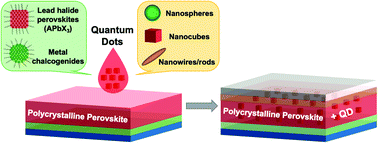Incorporating quantum dots for high efficiency and stable perovskite photovoltaics
Abstract
Lead halide perovskites have been widely studied for successful photovoltaic applications because of their exceptional optoelectronic properties, high photoconversion efficiencies, facile solution process and low cost. However, both organic–inorganic hybrid perovskite and all-inorganic perovskite solar cells still face the challenges with respect to higher photovoltaic performances and long-term stabilities against various environmental factors. To address these stability issues, solution-processed colloidal perovskite nanocrystals have been introduced into perovskite solar cells either as the sole light absorber material, or a surface additive for bulk perovskite films. The incorporation of perovskite quantum dots onto bulk perovskite thin films has shown great potential on improving the band alignment in solar cell structures, passivating bulk and surface defects, and enhancing overall device performances. Here in this perspective, we summarize the recent development on integrating semiconductor nanocrystals, including perovskite and metal chalcogenide quantum dots, onto bulk perovskite thin films for solar cell device fabrication. We also highlight and provide an outlook of the ongoing research studies regarding how the function and mechanism of this nanocrystal incorporation, the distribution of the added components, as well as the processing route, the chemical composition and the morphology of the nanocrystal can affect the fabricated device performances.

- This article is part of the themed collection: Journal of Materials Chemistry A Recent Review Articles


 Please wait while we load your content...
Please wait while we load your content...